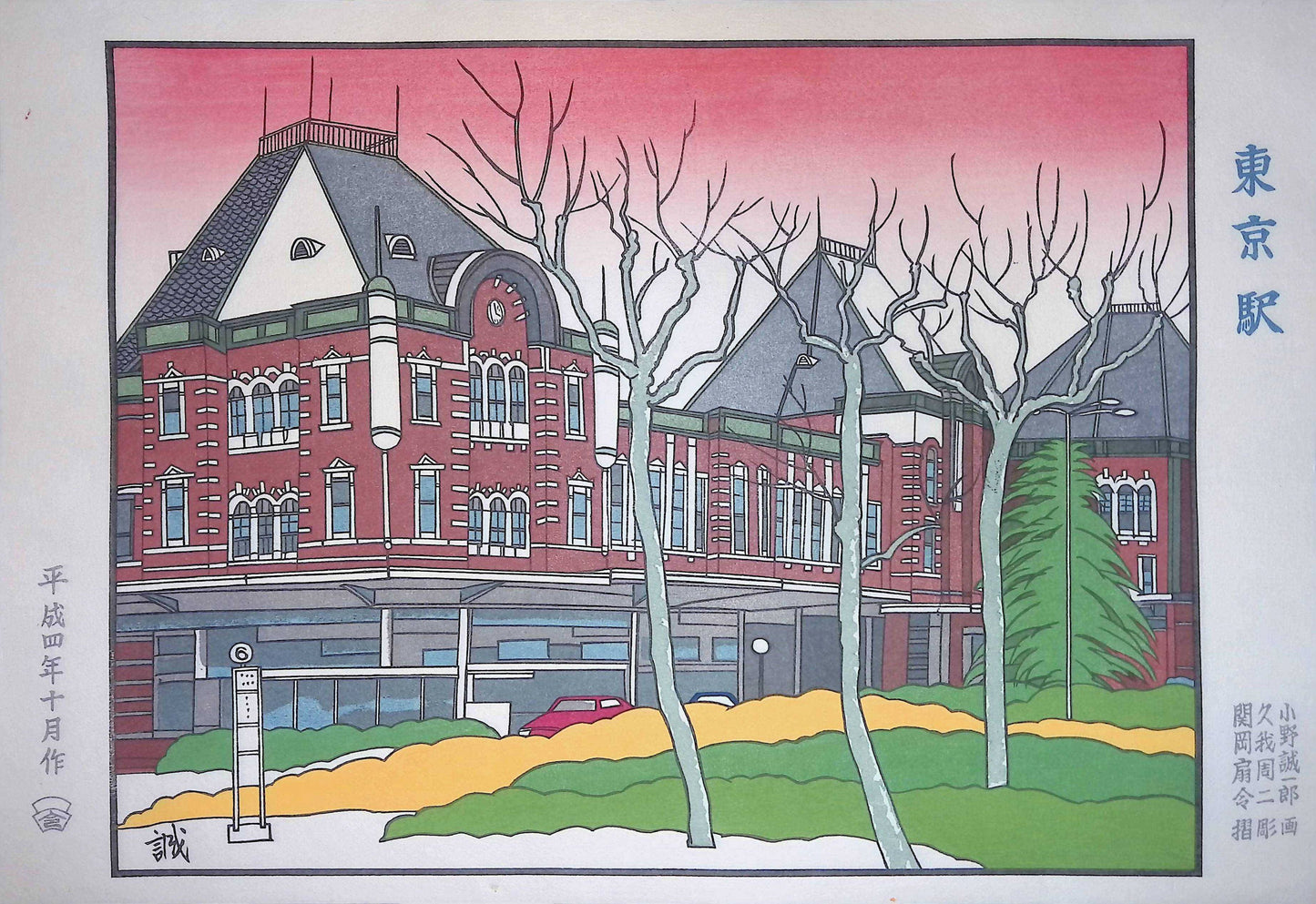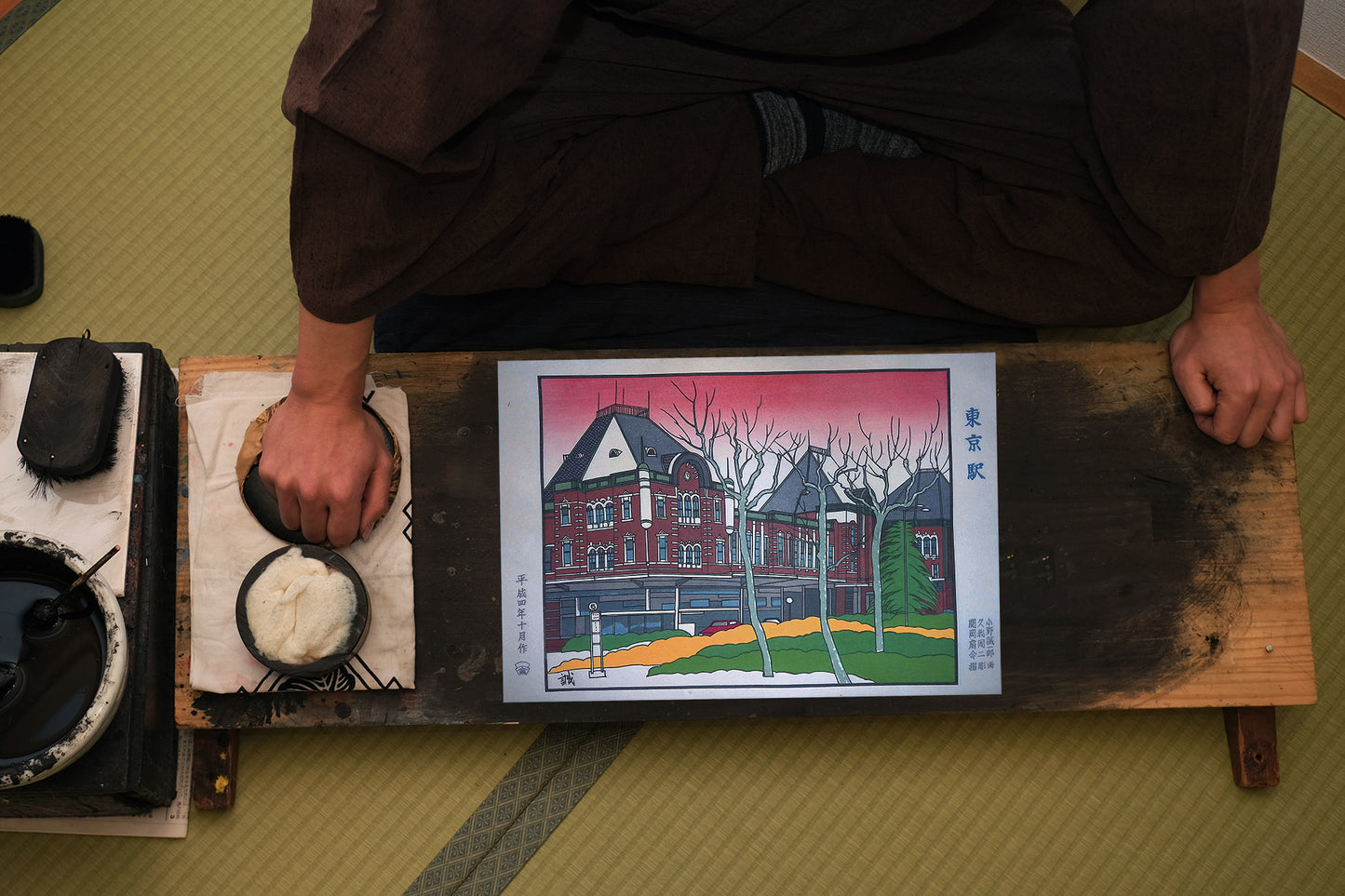関岡木版画
東京駅(現代版画)
東京駅(現代版画)
Couldn't load pickup availability
- Hand-printed using hand-carved woodblocks and handmade Japanese kōzo washi paper in Japan.
題 東京駅
絵 小野誠一郎
彫・摺 関岡木版画工房
東京駅駅舎を表現した作品。空の赤いぼかしが特徴的。
The Process of Creating a Woodblock Print
The Process of Creating a Woodblock Print
Artists, woodblock carvers, and woodblock printers work closely together at Sekioka Woodblock Printing Studio. For example, after a printer receives a private order for a set of senshafuda (small prints to attach to shrines featuring the customer’s name (now more commonly used as business cards)), the printer will either approach an artist or create the design himself/herself based on the client’s design requirements. After approval, the printer provides the carver with the complete design, color designation, and outlines for the senshafuda.
The carver then cuts the outlines for the design into cherry wood, using both sides of each woodblock (one woodblock ‘face’ must be carved for each colour used). Once the woodblocks are carved, the printer can start printing the design on washi paper. The pigment applied to each woodblock is pressed onto the paper with a baren, a round flat printing tool made of bamboo.
The production of a woodblock print through this method can only succeed with a streamlined process and good teamwork. The Arakawa Artisan Training Project facilitates this process by introducing students to each other and having them complete the same training. The carvers and printers at Sekioka Woodblock Printing Studio completed their training around the same time, and one of the program’s teachers is also a printer and artist for the Sekioka Studio.
Workflow in the Edo Period
Workflow in the Edo Period
In the Edo period, a publisher would commission an artist to produce paintings and choose colours for prints to be made. Some artists, like Hokusai, were known for only drawing outlines in black pigment, informing the publisher about colour designations only in notes.
The publisher would then commission a woodblock carver to carve the painting in woodblocks usually made from Sakura (cherry wood). Each pigment used required a respective woodblock to be carved, so for economic reasons, both sides of a woodblock were carved. A painting consisting of ten pigments, for example, would have typically required five carved woodblocks.
Finally, a printer was commissioned by the publisher to print the illustration using pigments and the carved woodblocks. The first batch of prints usually consisted of 200 sheets, to test the waters. Based on demand, the publisher could then commission the printer to produce an extra 100, 200, or even 1000 prints. The publisher would usually provide the printer with the paper (handmade washi) required.
The publisher became the sole owner of the printing rights but could sell these rights if desired. Rights to an illustration expire in Japan seventy years after the artist’s death, as is evident from the prolific use of ukiyo-e illustrations in merchandise today.
After Japan opened its borders to international trade in 1853, new printing technologies entered the country and the demand for woodblock prints slowly decreased. As a result, Japanese publishers focused on new genres and formats like manga, magazines, and books printed with movable type. The number of woodblock craftspeople also slowly decreased, as they were no longer able to make a living. Luckily, there was still a small group of dedicated woodblock craftspeople who cherished the craft of woodblock printing and passed the skills on to new generations. Programs such as the recent Arakawa Artisan Training Project (Tokyo) help keep these crafts alive and strengthen the small but strong crafts community in Japan.
Arakawa Artisan Training Project
Arakawa Artisan Training Project
Programs such as the recent Arakawa Artisan Training Project (Tokyo) assist new students in learning woodblock printing crafts by supporting them and connecting them with existing Arakawa craftspeople. Tokyo’s Arakawa Ward prides itself on its rich crafts history and is committed to keeping such crafts alive with its range of training programs and events/exhibitions. Members of Kesapasa’s Sekioka Woodblock Printing Studio, Katayama Noren Dyeing Studio, and the Edo-Moji craftsperson Mekaru-san all completed their artisan training in Arakawa.
We are proud to state that Kesapasa is run by craftspeople for craftspeople. We have a deep understanding of the process of becoming a craftsperson in Japan and know what it takes to master a traditional craft. The system by which craftspeople are trained in Japan is known for requiring perseverance, patience, and mastery from its participants. It takes many years of training for an apprentice to master a skill and finally be able to call themself a craftsperson. We pride ourselves on our work and hope that our customers will share our love of traditional Japanese crafts.
Shipping and Returns
Shipping and Returns
Kesapasa offers two worldwide shipping options: standard and express shipping.
Worldwide standard shipping starts at 2000 Japanese Yen (€12,95 or $14) for all orders under 1kg and takes around 7 working days to arrive. Including an order process time of 2 to 3 days, you should receive your order in 10 business days.
Worldwide express shipping starts at 4000 Japanese Yen (€26 or $28) for all orders under 1kg and takes around 2 to 3 working days to arrive. Including an order process time of 2 to 3 days, you should receive your order in 5 to 6 business days.
Japan domestic shipping has a fixed price of 1000 Japanese Yen (€6,5 or $7) for all shipments to Japanese addresses and takes one business day to arrive after the day we ship your order. Including an order process time of 2 to 3 days, you will receive your order in 3 to 4 business days.
Returns
We have a 7-day return policy, which means customers can request a return up to 7 days after the arrival of an item.
Returns will be accepted if or when expectations have not been met or the purchasing customer is not satisfied with the product.
To be eligible for a return, the item in question must be in the same condition in which it was received, unworn or unused, with tags, and in its original packaging. Receipt or proof of purchase will also be required. Please note that customers are responsible for return shipping costs as well as any duties on all returned items.
Before returning an item, please contact us at kesapasashop@gmail.com.
When a return is accepted, instructions on how and where to send the return package will be sent by email. Items sent back to Kesapasa without notice (i.e. without an email requesting a return) will not be accepted.



Artisan's profile
Kesapasa’s mission is to present with full transparency the artisans/craftspeople who made products for the Kesapasa site and the processes behind the creation of these products. This woodblock print was hand-printed by Nobuto. Please click below to learn more about his journey.


